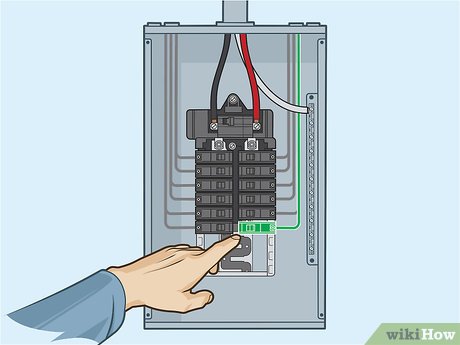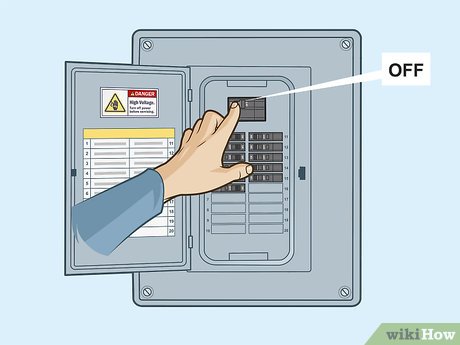How to Test the Amperage of an Outlet
Examining the Circuit Breaker
-
 Read the circuit label to see the amp level. Look at the individual circuits in the breaker box and search for a label. Note that most home circuits are labelled with '15' or '20,' since that's the traditional electrical current level that's safe to travel through most circuits. Take note of how much power your circuits can handle before you get started, so you have an idea of what you're working with.[1]
Read the circuit label to see the amp level. Look at the individual circuits in the breaker box and search for a label. Note that most home circuits are labelled with '15' or '20,' since that's the traditional electrical current level that's safe to travel through most circuits. Take note of how much power your circuits can handle before you get started, so you have an idea of what you're working with.[1]- For instance, a 20-amp circuit can handle more electricity than a 15-amp circuit.
- Some wiring systems may include both 15-amp and 20-amp circuits.
- Check which circuits line up with specific outlets. Look at the inner door of your circuit breaker and see if there's a chart or labeling system that specifies which circuits go with which outlets. Note that different groups of circuits power different outlets in your home, like the outlet for your dryer.[2]
- These charts can be confusing, so don't be discouraged if you can't figure out which circuit matches with which outlet.
- Test your circuits with a circuit breaker finder if you don't have a chart. Plug 1 part of the circuit breaker finder into the outlet you'd like to test, then drag the other part of the circuit breaker finder down the circuit breaker. Once this tool beeps, you'll know which breaker corresponds with the outlet.[3]
- You can purchase a circuit breaker finder at your local home improvement store.
- Double-check all of the circuits with the circuit breaker finder to make sure you've found the correct outlet.
Checking an Outlet Circuit
-
 Turn off your circuit breaker completely. Find where the circuit breaker is in your home. You may need to remove a few screws so you can access the individual circuits. For your own safety, flip your circuits to the 'off' position so you don't risk giving yourself a shock.[4]
Turn off your circuit breaker completely. Find where the circuit breaker is in your home. You may need to remove a few screws so you can access the individual circuits. For your own safety, flip your circuits to the 'off' position so you don't risk giving yourself a shock.[4]- If you know which circuit you'll be working with, just turn off that specific circuit instead.
- Most of the wiring for your home is managed and controlled through a large metal box, or circuit breaker. This box may be in your basement or some other part of your home. If you aren't completely sure, double-check your home's schematics for guidance.
- Attach an ammeter or multimeter clamp to the designated circuit wire. Find a multimeter (device that measures multiple settings) or ammeter (device that specifically measures amperage) with a claw-like clamp that can clip onto things. Take this clamp and attach it to the wire coming out of the designated circuit that you'd like to test.[5]
- Double-check that you're attaching the multimeter or ammeter to the correct wire, or else your readings may be off.
- You can attach your multimeter or ammeter to the circuit wire while your circuit breaker, but this is very risky if you're inexperienced.
- Set your device to the 'amp' setting. Check that your multimeter or ammeter is set to amps, which will be marked by an 'A,' or something similar. If your device isn't set to the correct setting, the readings won't be very helpful.[6]
- Switch the outlet circuit on so power is flowing. Flip the switch connected to your designated outlet so power flows through the wire and through your multimeter or ammeter. You may see the reading on your device alter slightly after you turn on the circuit breaker, which is normal.[7]
- If you don't feel comfortable working with live electricity at its source, call an electrician or repair professional for help.
- Connect a surge protecting strip into the outlet that you're testing. Find the outlet that you'd like to test and plug a surge protecting power strip into the socket. This strip will help you measure the amperage of multiple devices, and will also protect your devices from electrical surges.[8]
- If you're only testing 1 item, you may not need to worry about using a power strip.
- You can find power strips at most places that sell electronics.
- Plug 1 item into the power strip and see how many amps it draws. Check the multimeter or ammeter to see what the reading is. Keep in mind that certain devices will require more amperage than others.[9]
- For instance, a garbage disposal may only register as 4 amps, while a heat gun set to high may register as 12 amps.
- Add an additional item to the power strip and watch the amp level. Check the multimeter or ammeter and see what the reading is. Keep your circuit's total amp level in mind as you add different appliances so you don't overload your circuit.[10]
- For example, you likely wouldn't be able to plug your microwave, refrigerator, and dishwasher all into the same outlet.
- Disconnect the ammeter once you've finished testing. Unclip the device from the circuit wire so you can get your circuit breaker back to the way it was before. Store it someplace nearby in case you want to test any of your circuits again.
-
 Contact an electrician if there are any issues with your outlet amperage. Call a professional if anything seems weird or finicky with your wiring. Don't try to fix it yourself—wiring systems are really dangerous, and you can get hurt if you don't know what you're doing.[11]
Contact an electrician if there are any issues with your outlet amperage. Call a professional if anything seems weird or finicky with your wiring. Don't try to fix it yourself—wiring systems are really dangerous, and you can get hurt if you don't know what you're doing.[11]
4.1 ★ | 22 Vote



 How to See Frame Rates
How to See Frame Rates How to Contact an Art Gallery
How to Contact an Art Gallery List of errors arising after Windows 10 2004 update and how to handle it
List of errors arising after Windows 10 2004 update and how to handle it Control 1 Render farm remotely, from now on rendering is no longer a problem
Control 1 Render farm remotely, from now on rendering is no longer a problem Appeared TikTok clones, pay video viewers, climbing to the top 1 App Store
Appeared TikTok clones, pay video viewers, climbing to the top 1 App Store Close-up of the world's largest crane, capable of lifting 5,000 tons of cargo at a time
Close-up of the world's largest crane, capable of lifting 5,000 tons of cargo at a time